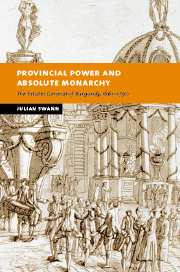Book contents
- Frontmatter
- Contents
- List of illustrations
- List of figures
- List of appendices
- List of map
- Preface
- List of abbreviations
- Map: The duchy of Burgundy in the eighteenth century
- 1 Historians, absolute monarchy and the provincial estates
- 2 Ancien régime Burgundy
- 3 The Estates General of Burgundy
- 4 Nosseigneurs les élus and the officers of the Estates
- 5 The provincial administration: authority and enforcement
- 6 ‘It's raining taxes’. Paying for the Sun King, 1661–1715
- 7 Provincial administration in an age of iron, 1661–1715
- 8 The limits of absolutism: crown, governor and the Estates in the eighteenth century
- 9 Provincial rivalries: the Estates and the Parlement of Dijon in the eighteenth century
- 10 Tax, borrow and lend: crown, Estates and finance, 1715–1789
- 11 An enlightened administration?
- 12 The coming of the French revolution in Burgundy, 1787–1789
- Conclusion
- Appendices
- Bibliography
- Index
5 - The provincial administration: authority and enforcement
Published online by Cambridge University Press: 05 July 2009
- Frontmatter
- Contents
- List of illustrations
- List of figures
- List of appendices
- List of map
- Preface
- List of abbreviations
- Map: The duchy of Burgundy in the eighteenth century
- 1 Historians, absolute monarchy and the provincial estates
- 2 Ancien régime Burgundy
- 3 The Estates General of Burgundy
- 4 Nosseigneurs les élus and the officers of the Estates
- 5 The provincial administration: authority and enforcement
- 6 ‘It's raining taxes’. Paying for the Sun King, 1661–1715
- 7 Provincial administration in an age of iron, 1661–1715
- 8 The limits of absolutism: crown, governor and the Estates in the eighteenth century
- 9 Provincial rivalries: the Estates and the Parlement of Dijon in the eighteenth century
- 10 Tax, borrow and lend: crown, Estates and finance, 1715–1789
- 11 An enlightened administration?
- 12 The coming of the French revolution in Burgundy, 1787–1789
- Conclusion
- Appendices
- Bibliography
- Index
Summary
THE CHAMBER OF ÉLUS IN SESSION
If the myth of ignorant élus has been laid to rest, their actual contribution to the running of the provincial administration remains to be proven. According to critics such as Malesherbes, the élus were rarely present in Dijon, leaving their chamber closed, or in the hands of the permanent officers. As we shall see, these accusations were inaccurate, and to fully appreciate the activities of the élus it is necessary to define their competence, examine their working practices and consider how decisions reached in Dijon were put into effect. A simple plan (plate 4) sketched early in the eighteenth century offers a glimpse into the chamber itself. It was the élu of the clergy, or in his absence the representative of the nobility, who presided over the work of the assembly from his armchair positioned at the head of a large rectangular bureau around which were seated the other élus, the deputies of the Chambre des Comptes and the vicomte-mayeur of Dijon. The serving secrétaire des états sat facing the president from the other end of the table, and behind him were the two procureurs syndics. A separate desk accommodated the clerks recording the deliberations, and further seating was reserved for any ‘persons of distinction’ who might enter the chamber. Although their presence was not obligatory, the treasurer general, conseils des états and the provincial engineer were regularly summoned for consultation.
- Type
- Chapter
- Information
- Provincial Power and Absolute MonarchyThe Estates General of Burgundy, 1661–1790, pp. 126 - 153Publisher: Cambridge University PressPrint publication year: 2003



